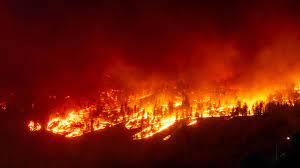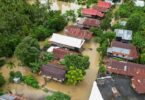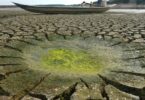TORONTO (AFP): Wildfires bore down on two Canadian cities Friday, with firefighters in the west bracing for another “scary” night as stunned refugees from the far north began arriving at shelters after their entire city was evacuated.
The two fronts in British Columbia and the Northwest Territories are just the latest in a summer of devastating wildfires across the country that have forced tens of thousands from their homes and left millions of acres scorched.
The blazes have caused “terrible loss,” Prime Minister Justin Trudeau told reporters after meeting evacuees from Yellowknife, capital of the Northwest Territories, as they arrived in Edmonton, Alberta, hundreds of miles (kilometers) to the south with no idea when they may return home again.
Meanwhile the premier of western British Colombia, David Eby, declared a state of emergency there late Friday.
The announcement came as the fire burning west of Kelowna, a town of 150,000 people in the Okanagan Valley, exploded a hundred fold in size to 6,800 hectares over the past day.
Officials described firefighters being forced to pull back and some becoming trapped behind lines while making “heroic efforts” to rescue residents.
“We fought hard last night to protect our community,” local fire chief Jason Brolund told a briefing on Friday. “A significant number of structures were lost,” he said, but no injuries or fatalities were reported.
“It was like 100 years of firefighting all at once, in one night,” he said, adding that he expected “another scary night tonight” under an eerie glow of the fires.
Thousands of households on Kelowna’s west side were ordered evacuated or told late Thursday to be ready to leave at a moment’s notice.
“The situation is unpredictable right now and there are difficult days ahead,” Eby told a news conference.
– ‘Empty’ –
In the far north, Yellowknife was a ghost town late Friday after ordering its entire population to leave by the afternoon — the largest ever evacuation from the region.
Most of its 20,000 inhabitants left by car, snaking along the lone highway connecting the remote capital of the Northwest Territories to southern Alberta province.
The nearest evacuation center is 1,150 kilometers (700 miles) away, in Alberta, where several sites have been set up.
Almost 4,000 people flew out, officials said, with a pilot on one of the relief flights telling Canadian media that the lakeside city was “pretty empty.”
Among the exhausted evacuees being ferried to hotels was Byron Garrison, 27, who landed in Calgary late Friday with his girlfriend and a friend, carrying only a small bag with two changes of clothes.
The three looked tired, and scared.
“I feel lost because I don’t have any idea what is going to happen now,” Garrison told AFP. “We don’t know what we’ll do now.”
It was a sentiment echoed by Katel Koumhawa, originally from Cameroon, who moved to Yellowknife earlier this year.
He made the long drive from the northern city to Calgary to save his car from the flames.
He and his family are “happy” they have been saved, he told AFP.
But “we don’t know about tomorrow,” he added. “About our lives, our jobs. You don’t know if everything will be the same tomorrow.”
Yellowknife has not been abandoned: crews remained to erect defenses as the flames approached, while water bombers have been seen flying low over the city and the Canadian military is also helping out.
Several towns and Indigenous communities had already been evacuated. The flight from Yellowknife means half the population of the near-Arctic territory has been displaced.
The confusion and terror of the fires and evacuations have been compounded by Meta’s blocking of Canadian news on Facebook and Instagram.
The decision — made earlier in response to a new law requiring digital giants to pay publishers for articles — has complicated wildfire information sharing.
Heritage Minister Pascale St-Onge on Friday called the ban “reckless” and demanded Meta lift it “for the safety of Canadians facing this emergency.”
– Record-setting wildfire season –
Canada is experiencing a record-setting wildfire season, with official estimates of over 14.0 million hectares (34.6 million acres) already burned — almost twice the area of the last record of 7.3 million hectares. Four people have died so far.
In addition, the fires have emitted an unprecedented amount of carbon dioxide.
Scientists say human-caused global warming is exacerbating natural hazards, making them both more frequent and more deadly.
“It shows how quickly our climate is changing if a place like Yellowknife, so close to the Arctic Circle, is on fire,” Adria McPherson told the CBC while fleeing the fires in the north by car.
The evacuation of Yellowknife is the second time an entire Canadian city has been cleared due to wildfires since 100,000 residents of Fort McMurray in Alberta’s oil and gas producing heartland were forced out in 2016.
Heat and wind threaten to stoke Spain wildfires
Spanish firefighters were set to deploy extra aircraft in their battle against raging Tenerife wildfires on Saturday, as renewed heat and wind threatened recent progress in bringing the blaze under control.
The blaze, which has forced 4,500 people to flee, broke out late Tuesday in a mountainous area of the holiday island.
Officials say it is the most “complex fire” to hit the Canary Islands in 40 years.
Friday’s firefighting efforts “progressed well, although the fire is still out of control”, Canary Islands regional president Fernando Clavijo told reporters in a late-night briefing.
The blaze has so far destroyed 5,000 hectares (more than 12,300 acres) of land and has a perimeter of 50 kilometres (30 miles), he said.
Montserrat Roman, head of civil protection for the seven-island archipelago, said more than 225 firefighters would continue efforts during the night to tackle the fire, which had already affected 10 municipalities.
On Saturday, 19 aerial units would be drafted in to continue the work, which was likely to be complicated by high temperatures and “strong gusts of wind”, she said.
More than 4,500 people had been evacuated, but the number stuck inside their homes had fallen to just under 1,700 after a confinement order was lifted for some 2,200 residents as conditions eased in La Esperanza near the airport, she said earlier.
During the day, officials said there had been a “favourable evolution” on the main front of the fire, which had advanced more slowly and predictably overnight, making it easier for crews to tackle the flames.
“Overnight the fire and the weather behaved normally,” said Clavijo, explaining that the wind, the temperature and the behaviour of the fire on the first two nights had been “highly unusual”.
Although air humidity levels rose overnight and the winds eased, helping firefighters’ efforts, forecasters warned the mercury was set to soar again over the weekend in Tenerife.
– Visible from space –
The fire has generated a pillar of smoke nearly four kilometres high that is visible on satellite pictures and has risen above the summit of Mount Teide, the volcano that towers over the island.
Reaching a height of 3,715 metres (12,200 feet), Teide is Spain’s highest peak and a popular tourist destination, but all roads to the national park were closed on Thursday and would remain shut, the authorities said.
The focal point of the fire lies some 20 kilometres away on the steeply forested slopes below, with the blaze sending clouds of ash across much of the island.
“This is probably the most complex fire we’ve ever had in the Canary Islands in at least the past 40 years,” Clavijo said Thursday, citing the topography of the area, the high temperatures and winds that change direction frequently.
The blaze broke out after the archipelago suffered a heatwave that left many areas tinder-dry.
As global temperatures rise due to climate change, scientists have warned heatwaves will become more frequent and intense.
In 2022, a particularly bad year for wildfires in Europe, Spain was the worst-hit nation, with nearly 500 blazes that destroyed more than 300,000 hectares, according to the European Forest Fire Information System (EFFIS).
So far this year, EFFIS figures show almost 76,000 hectares have been ravaged by 340 fires in Spain, one of the European countries most vulnerable to climate change.







